When evaluating web site builder platforms, it’s important to align each your online business and workforce expectations.Whereas looking for the proper instrument to create my very own digital portfolio, I explored among the hottest choices — Webflow and WordPress. This led me to run a direct comparability between the 2 to grasp how they measure up.
Whereas Webflow provided intuitive and responsive graphics, WordPress centered extra on seamless APIs, a UI-friendly IDE, and exception dealing with. To maintain my comparability goal and decision-focused, I additionally in contrast the 2 instruments primarily based on real-time G2 evaluations and stacked them towards one another. Right here’s a fast characteristic comparability of each web site builder platforms.
Webflow vs. WordPress at a look
| Characteristic |
Webflow |
WordPress |
| G2 score |
4.4/5 |
4.4/5 |
| Greatest for |
Constructing services or products web sites with a contemporary consumer interface |
Creating blogs or constructing scalable web sites |
| E-commerce instruments |
Consumer-friendly instruments are constructed immediately into the platform, which is good for small to medium-sized shops. |
Highly effective e-commerce capabilities by plugins like WooCommerce, appropriate for all sizes of companies. |
| Safety and compliance |
Absolutely managed, much less management, built-in SSL & safety. |
Self-managed, excessive management, full compliance attainable with handbook setup. |
| Integrations |
Provides integrations with advertising and marketing automation instruments like HubSpot, Mailchimp, Zapier, Formstack and so forth. |
Helps integrations like WooCommerce, HubSpot, Mailchimp, Yoast search engine optimisation, Ecwid, Omnisend and AI instruments like Kodee. |
| Customization (Design and backend) |
Excessive design flexibility, restricted backend, higher for smaller-scale tasks |
Limitless entrance & backend management, scalable to any measurement |
| Design and templates |
Extremely visible drag-and-drop design interface. Fashionable, responsive templates optimized for designers looking for customizations. |
Large number of free and premium themes. It presents full customization by themes and code, which is good for individuals who need most management however require technical information. |
| search engine optimisation and efficiency |
Constructed-in, streamlined search engine optimisation instruments and clear code construction. Glorious web site pace and cell responsiveness. Computerized SSL and optimized internet hosting. |
Robust search engine optimisation capabilities utilizing plugins like Yoast and Rank Math. Website efficiency is determined by internet hosting alternative and configuration; it requires user-managed optimization. |
| Free plan |
Sure, with pages and content material administration system (CMS) objects capping. |
Provides a free plan with a WordPress area. |
| Pricing |
Starter: $0/month
Fundamental: $14/month
CMS: $23/month
Enterprise: $39/month
|
Private: $4/month
Premium: $8/month
Enterprise: $25/month
Commerce: $45/month
Enterprise: Approx $25000/yr
|
Primarily based on preliminary understanding, Webflow is finest if you happen to favor ease-of-use, fashionable design, and built-in efficiency with no need in depth technical abilities. Then again, WordPress is nice for optimum flexibility and in depth plugin assist. When you’re comfy managing the technical side or have the assist of a developer, WordPress is an effective platform.
Notice: The small print under mirror the merchandise’ present capabilities as of August 2025. Each corporations consistently add superior options; some capabilities might change over time.
Earlier than we start the head-to-head testing, I would like you to look at the net builder platforms and their options extra carefully. They’re each spectacular. However the satan’s within the particulars, is not it? Let’s break down and see what units them aside.
Webflow vs. WordPress: What’s completely different?
Beneath is an outline of the important thing variations between Webflow and WordPress.
- Platform sort: I discovered Webflow to be an entire visible net design platform with a CMS and built-in internet hosting. You get full visible design freedom with cascading fashion sheets (CSS)- stage styling by way of drag-and-drop. It’s constructed for pixel precision. Then again, WordPress presents a completely managed running a blog and web site platform constructed on WordPress core. Its design relies on pre-built themes. When you want customization past theme, you have to be on a marketing strategy or increased. Customization past themes typically requires a Marketing strategy or increased. WordPress is extra appropriate if you happen to can code to incorporate the required customizations. Webflow is a extra acceptable alternative for creating engaging web sites with out figuring out a lot coding.
- E-commerce assist and CMS performance: Webflow eCommerce is native. It helps merchandise, checkout, taxes, transport, and many others. I really feel it’s appropriate for small shops. Then again, e-commerce is obtainable by way of WooCommerce (solely on the Marketing strategy or increased) in WordPress, which presents increased scalability. For the CMS, WordPress delivers basic posts/pages and customized put up sorts. You possibly can go in-depth by utilizing plugins. Whereas Webflow presents in-built CMS, and plugins built-in in a single platform, it is nonetheless a smaller vary as in comparison with WordPress’s dynamic library.
- search engine optimisation instruments: Webflow presents built-in search engine optimisation instruments with choices to edit meta title, descriptions, alt textual content, and add 301 redirects and an extensible markup language (XML) sitemap for energy customers. Webflow has additionally built-in internet hosting (powered with AWS and CDN), constructed for pace, scalability, and safety, not like WordPress. In WordPress, you get fundamental search engine optimisation on the decrease plan. The Yoast plugin is obtainable on Enterprise+ plans, requiring you to spend extra. This creates a hurdle as you’ll be able to’t optimize for search engine optimisation from day one (contemplating you’re on a Private or Premium plan). Webflow doesn’t restrict you this manner. I used to be capable of optimize from the preliminary begin in Webflow.
- Localization and multilingual assist: Webflow now presents native localization options (launched in late 2023 and expanded in 2025) that allow you to handle a number of language variations throughout the similar undertaking, with visible modifying for every variant. In WordPress, multilingual performance requires plugins like WPML, Polylang, or Weglot, which might be highly effective however add upkeep complexity and potential plugin conflicts. If you’d like multilingual proper out of the field, Webflow’s strategy is less complicated, although WordPress presents extra flexibility for extremely personalized localization workflows.
- Enterprise collaboration: Webflow’s Workspace plans present team-level collaboration with role-based permissions, staging environments, and publishing controls. Additionally they combine with instruments like Jira, Asana, and Slack for workflow alignment, making it easy for design, content material, and advertising and marketing groups to work in parallel with out developer bottlenecks. In WordPress, enterprise collaboration is normally achieved by way of third-party plugins, customized workflows, or managed enterprise WordPress providers (e.g., WordPress VIP), which supply far deeper scalability and governance however require a extra complicated setup.
Webflow vs. WordPress: What’s related?
There are a number of similarities between the 2 platforms, together with:
- Web site constructing capabilities: Each Webflow and WordPress enable customers to create web sites with blogs, portfolios, and even e-commerce shops with out truly coding them, besides when complicated customizations are wanted. They assist a completely responsive design. Webflow makes use of visible breakpoints, whereas WordPress themes typically come mobile-optimized. For us, this implies we don’t must code to design a web site; we will do it by utilizing easy drag-and-drop components.
- Third-party integrations: Each Webflow and WordPress facilitate integration with instruments like Stripe or Mailchimp. WordPress integrates nearly with any instrument by plugins and software programming interfaces (APIs), whereas Webflow integrates by way of native or third-party embeds. Each allow you to join with exterior instruments like CRMs, e mail advertising and marketing platforms, analytics, and e-commerce programs, enabling workflows that transcend the default options.
- Neighborhood and sources: Webflow and WordPress have massive, lively consumer communities. You get to entry group sources within the type of Q&As in boards. Each platforms have an honest quantity of tutorials, serving to newcomers navigate any studying curve they may face.
How I in contrast Webflow vs. WordPress: My analysis standards
In my earlier jobs, I spent virtually one yr on every Webflow and WordPress platform. I pretty perceive the nitty-gritty of the 2 platforms. Nonetheless, for this comparability, I made a decision to construct from scratch to refresh and replace my information.
I examined each the instruments for designing a homepage of a advertising and marketing providers web site for a model, Dayfive. I in contrast Webflow and WordPress for user-friendliness, flexibility, design options, search engine optimisation, efficiency, and pricing.
I spent per week testing each platforms to discover all their options and keep away from lacking something essential. My aim was to discover a user-friendly interface that made customization simple, so the testing standards mirrored that. For this, I used a mixture of fundamental and superior design components to create a visually interesting web site with the suitable performance.
Having constructed a number of easy web sites for my providers and startups, I approached this comparability with expertise and objectivity. I used the identical content material and options on each platforms; solely the design and inventory photos assorted.
Now, let’s dive into the precise testing and see how Webflow and WordPress carry out aspect by aspect.
Disclaimer: This comparability relies on my hands-on expertise with the 2 website-building platforms as of August 2025. Some options and performance might have advanced since. I like to recommend referring on to Webflow and WordPress’ official sources or assist groups for essentially the most up-to-date data.
Webflow Vs. WordPress: How they really carried out in my checks
I explored each platforms in-depth, highlighting why sure options stand out and what they imply for actual customers. By testing every instrument, I uncovered its strengths and limitations for a transparent, hands-on comparability. Curious concerning the outcomes? Let’s get began!
Consumer-friendliness and adaptability
I began with Webflow. Signed in and selected a template; we’re already in.
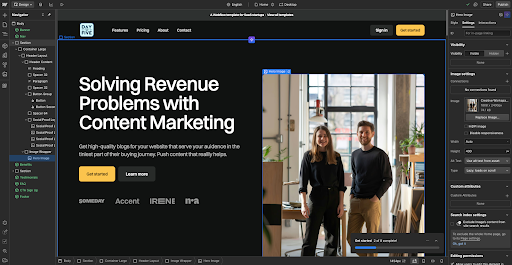
As somebody with prior design expertise, I discover it superb and simple to navigate and fiddle with. Sadly, if you happen to’re not into the UI/UX aspect of issues or an “artist,” you’ll be bombarded with a clear display however overloaded with buttons and settings.
Now, that “get began” tutorial, though annoying, is nice. It has small movies that present you precisely what to do if you happen to’re new. The platform is pretty versatile and nice for designing the entrance finish.
You will get into the small print and fiddle till you right it. The layers system remains to be sophisticated to grasp if you happen to’re fully new. Actually, it’s a bit powerful to rearrange issues utilizing their layers system for me as nicely, however then once more, at the least I don’t should study HTML and CSS to do one thing concerning the appears to be like, and I’m pleased with that.
I experimented with Webflow’s CMS. Whereas user-friendly, it requires a while to totally make the most of its potential.

Webflow additionally has many app integrations, comparable to Figma, Zapier, and Loopie, for animations and different functionalities.
To experiment with WordPress, I selected the “Lativ” theme and labored across the dwelling web page’s content material.
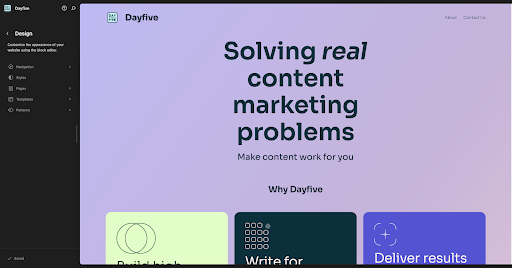
I discovered WordPress to be tremendous simple to make use of, particularly for newcomers. The UI is clear and doesn’t bombard you with an excessive amount of data. A standard one that has expertise with Microsoft Phrase or Google Docs can simply create a web site with WordPress.
I appreciated Webflow’s templates to be a lot prettier than WordPress. Nonetheless, you want adequate time to get a completely purposeful web site. You get a code editor on WordPress, which you need to use to customise the positioning extra extensively.
General, each Webflow and WordPress are nice instruments for designing a web site from scratch. Nonetheless, WordPress can be simpler to work with for an absolute newbie because the consumer interface is tremendous clear, saving complexities for later. For consumer friendliness and adaptability, I’ll go together with WordPress.
Winner: WordPress 🏆
Design options and capabilities
From a design standpoint, Webflow and WordPress supply respectable instruments and performance. I discovered Webflow to be extra visually customizable than WordPress. Webflow presents a elements characteristic that permits you to reuse components on completely different pages upon getting created them. This may be one thing so simple as a set of testimonials. When you modify a set, it will get modified in all situations.
Webflow does supply flexibility right here. When you want to change just one assortment occasion, you’ll be able to go to settings and create a brand new property. It will make adjustments solely in that specific occasion.
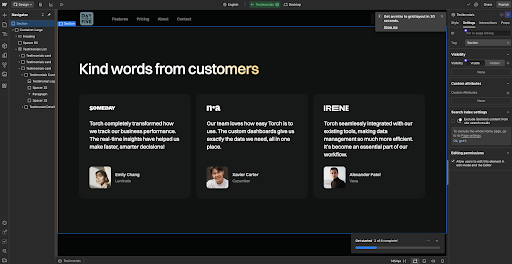
You get choices to alter the format of components on the web page with easy button clicks. It’s tremendous simple to remodel a block format right into a grid or a flex. This makes it simple to work with the web site builder software program.
Webflow permits entry to the whole design instrument on the right-hand aspect panel. You possibly can change the margins, typography, colour, padding, icon, photos, and even the tiniest belongings you see on the web page.
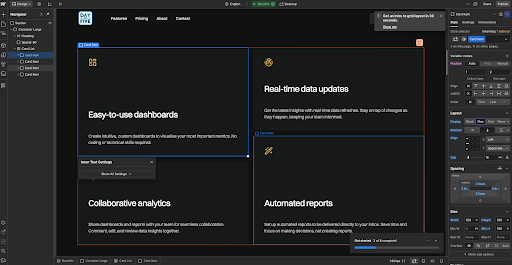
WordPress, then again, retains its UI clear however makes a trade-off with the extent of design options it presents to customise components on a web page visually. On the right-hand menu, you’ll be able to configure fonts, dimensions, colour, and many others. Nonetheless, the choices are restricted.
For extra in depth customizations, you’ll should get technical assist from somebody who can code. For builders, WordPress is very customizable (greater than Webflow.) Nonetheless, coding takes loads of time.

In relation to modifying line objects, WordPress presents AI help to generate/edit textual content on the go. It turns into simpler to take inspiration by AI and self-edit completely different textual components on the web page.
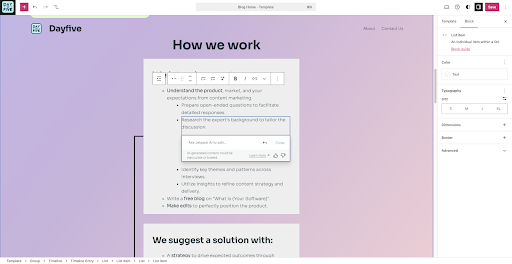
Webflow does supply an choice in its CMS to auto-populate pattern blogs, however it’s at the moment beta-testing. That is helpful if you happen to’re designing for a shopper and wish to add some placeholder components to provide them an outline.
From a options perspective, Webflow presents higher methods to customise the web site, which is helpful for newcomers visually. You are able to do the identical with WordPress, however it requires time and coding. Certain, WordPress plugins assist, however it is advisable add customized code for superior customization.
Winner: Webflow 🏆
Content material and search engine optimisation
WordPress is thought for running a blog and content material. I discovered nothing in my check inspiring me to problem this assertion.
I’d primarily write about WordPress and Webflow’s content material and search engine optimisation options primarily based on my expertise (one yr every) in working with these instruments. Webflow’s content material administration system (CMS) is initially difficult to navigate. You might want to do extra monotonous and repetitive work, for instance, manually writing the Creator’s title or bio each time you publish a weblog. This was the case with me.
Optimizing the platform’s title, meta description, and alt textual content was simple from an search engine optimisation standpoint. Nonetheless, the platform would not sustain once you’re working extensively towards off-page optimization. For instance, once you hyperlink extensively to different web sites in stat roundups, there was no simple means so as to add a “no-follow” attribute to hyperlinks.
Evaluating this immediately with WordPress CMS, you’ll be able to edit the hyperlink and test the no-follow attribute. It was tremendous simple to do on WordPress. It provided a variety of plugins to make our work simpler. For instance, the Yoast plugin helped rather a lot in optimizing the on-page components of a webpage.
On a normal notice, WordPress presents a variety of plugins that will let you carry out numerous actions if you happen to don’t wish to write code.
From a technical search engine optimisation perspective, working with the WordPress CMS was comparatively simple because it permits us so as to add Schema markup in JSON to the customized code. In my expertise, I didn’t discover this selection to do it simply on Webflow.
Winner: WordPress 🏆
Pricing
Webflow presents a free plan. Its fundamental plan begins at $14 per thirty days and delivers all of the options essential for sensible static web sites. The CMS plan, priced at $23 per thirty days, is appropriate for web sites heavy on dynamic content material. Bigger enterprise web sites that want extra flexibility can go together with the $39/month plan.
There are non-compulsory add-ons like:
- Optimize: Prices $299/month to maximise web site conversions.
- Analyze: Begins at $29/month that can assist you get actionable insights in your web site’s efficiency.
- Localization: Permits customers to localize a web site for audiences around the globe. It begins at $9/month.
On the flip aspect, WordPress.com presents the next plans:
- Private: $4/month
- Premium: $8/month
- Enterprise: $25/month
- Commerce: $45/month
Further prices apply once you add paid plugins or select a paid theme to create your web site.
Winner: Break up
Webflow vs. WordPress: Head-to-head comparability desk
Right here’s a desk displaying the net builder software program that wins.
| Characteristic and performance |
Winner |
Why it received |
| Consumer-friendliness and adaptability |
WordPress🏆 |
WordPress is extra user-friendly. When customers begin, they aren’t bombarded with tons of options and complexities. |
| Design options and capabilities |
Webflow 🏆
|
I appreciated Webflow’s in depth customizability (visible). It permits newcomers or non-designers to ramp up rapidly and convey their net pages into the daylight. |
| Content material and search engine optimisation |
WordPress 🏆 |
I felt WordPress has extra options and performance on the subject of catering to search engine optimisation and content material use circumstances. You should use completely different plugins to finish your job successfully. |
| Pricing |
Break up |
Each platforms have pretty affordable pricing. It’s finest to package deal the perfect of each platforms collectively. Many design companies supply the front-end on Webflow whereas their CMS is on WordPress. This presents beautiful design with visible customizability along with a scalable CMS. |
Key insights on Webflow vs. WordPress from G2 information
I checked out assessment information on G2 primarily based on actual customers’ experiences to search out strengths and adoption patterns for Webflow and WordPress. Here is what stood out:
Satisfaction rankings
- Webflow excels in ease of use (84%), ease of setup (88%), and ease of doing enterprise (92%).
- WordPress ranks excessive in ease of use (87%). Nonetheless, it reveals respectable satisfaction rankings for ease of doing enterprise (87%) and ease of setup (84%).
Industries represented
- Webflow dominates in design, advertising and marketing, promoting, IT providers, pc software program, and graphics design.
- WordPress has a robust presence in advertising and marketing and promoting, IT providers, pc software program, the Web, and writing and modifying.
Highest-rated options
- Webflow excels in visualization instruments (88%), hypertext markup language (HTML) and CSS Editors (85%), and content material components libraries (85%).
- WordPress stands out for visualization instruments (88%), content material components libraries (88%), and templates library (86%).
Lowest-rated options
- Webflow struggles with advertising and marketing instruments integration (77%), vector graphics instruments importing and integration (80%), and WYSIWYG editor integration (81%).
- WordPress additionally struggles with vector graphics instruments importing and integration (83%), WYSIWYG editor integration (84%), and advertising and marketing instruments integrations (85%).
Webflow vs WordPress: Ceaselessly requested questions (FAQs)
1. How do you migrate from WordPress to Webflow?
Begin by auditing your WordPress web site and exporting content material by way of the built-in instrument or a plugin like WP All Export. Import the information into Webflow’s CMS, rebuild your design, exchange WordPress-specific plugins with Webflow options, replace search engine optimisation settings, and check completely earlier than launch.
2. Which web site builder is the perfect?
There isn’t a one-size-fits-all reply—it is determined by your targets. Webflow, WordPress, Wix, Shopify, and Framer are all widespread decisions, so the perfect builder is the one that matches your design, customization, and enterprise wants.
3. Do I want a CMS for my web site?
A CMS is crucial if you happen to plan to handle dynamic content material like blogs, product pages, or often up to date sections. For easy or static websites, you’ll be able to skip a CMS and use a light-weight builder or customized code as an alternative
4. What number of pages are allowed in Webflow free of charge?
The free Webflow plan permits as much as 2 static pages (comparable to Residence and About). To unlock extra pages or CMS performance, you’ll must improve to a paid plan.
5. Does Webflow host your web site?
Sure. Webflow consists of safe internet hosting with quick load occasions, backups, and SSL certificates. You can too export code to host your web site elsewhere if most well-liked.
6. How lengthy does it take to make a web site with Webflow?
A easy one-page web site can take a day or two, whereas a small multi-page web site (4–5 pages) might take as much as per week. The entire time is determined by your design complexity and required options..
7. Which is extra customizable, Webflow or WordPress?
WordPress is extra customizable general, providing huge plugins, themes, and backend management. Webflow offers sturdy design flexibility however much less backend extensibility.
8. Is Webflow or WordPress higher for e-commerce web sites?
WordPress (with WooCommerce) is extra highly effective for complicated shops due to deep customization and scalability. Webflow fits smaller retailers that prioritize smooth design and ease of use.
9. How does WordPress evaluate to Webflow for search engine optimisation?
WordPress presents stronger search engine optimisation flexibility with superior plugins like Yoast and Rank Math. Webflow has strong built-in search engine optimisation instruments, however fewer customization choices general.
10. How do Webflow and WordPress evaluate for web site pace?
WordPress presents stronger search engine optimisation flexibility with superior plugins like Yoast and Rank Math. Webflow has strong built-in search engine optimisation instruments, however fewer customization choices general.
Webflow vs. WordPress: My remaining verdict
WordPress has been round for a very long time, since 2003, whereas Webflow got here out in 2012. Each platforms supply numerous performance on the subject of net design. Plugins on WordPress make many roles simpler than once you strive them on Webflow. Nonetheless, Webflow is less complicated to customise and doesn’t require you to know coding to implement customizations.
You possibly can customise WordPress to a sure extent, however past that, you want technical net improvement experience. This makes Webflow simpler to make use of.
General, Webflow is an effective start line for companies because it presents many customization choices to create a shocking UI. WordPress is nice for mature corporations with extra complicated wants and scalability necessities. Many corporations merely use Webflow for the entrance finish and WordPress for the again finish, giving them the perfect of each worlds.
The “finest” among the many two will largely rely upon what you count on from the instrument. Interested in different net builder software program?
Try the highest Webflow and WordPress options in the marketplace.
This text was revealed in April 2025 and has been up to date with new data.
Sagar Joshi
Sagar Joshi is a former content material advertising and marketing specialist at G2 in India. He’s an engineer with a eager curiosity in information analytics and cybersecurity. He writes about subjects associated to them. You will discover him studying books, studying a brand new language, or taking part in pool in his free time.










